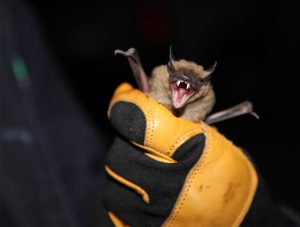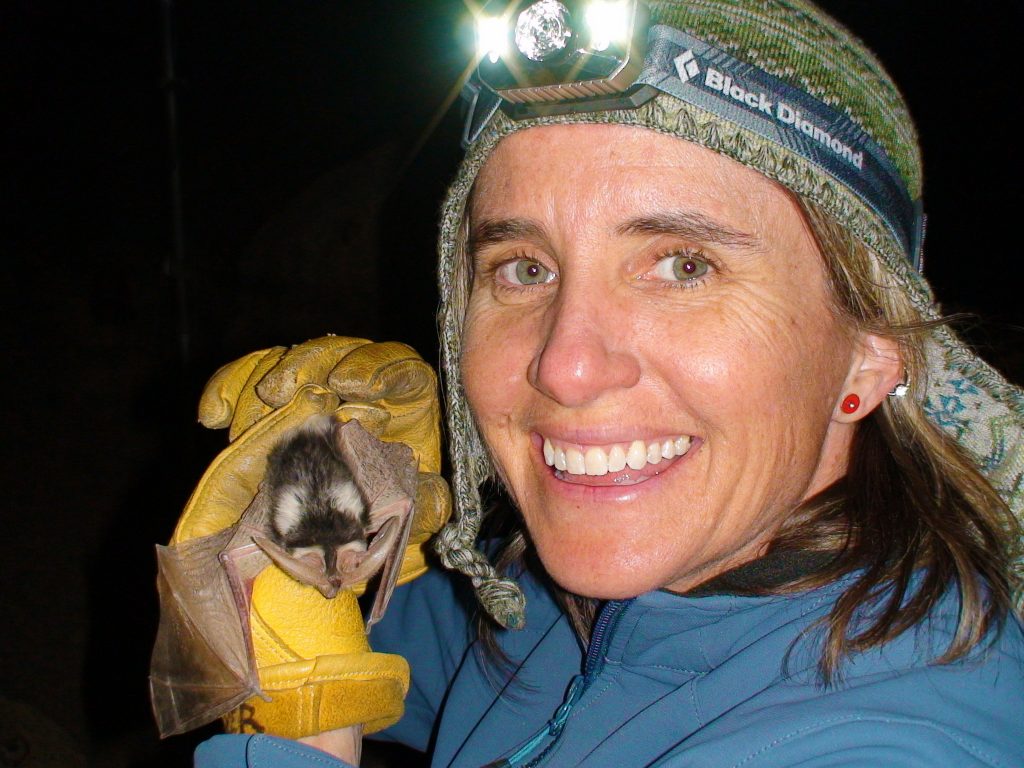By Heidi Toth
NAU Communications
The first rule of National Bat Week is: Don’t walk into a bat lab and call a bat ugly.
Assistant research professor Faith Walker and professor Carol Chambers, directors of the Bat Ecology & Genetics Lab in the School of Forestry at Northern Arizona University, spend their days—and many nights—studying this mammal, which is one of the most common and yet still most mysterious group of animals in the world. They’ve studied behavior, diet, size, relationships and population shifts, and now the NAU researchers are making an impact in the study of bats through examining feces.
“Bats are hard to study because they’re small and nocturnal and they fly, so we really have a poor idea of what bat species are where, when,” Walker said. “Guano is awesome because it doesn’t fly around—you can just go to a bat roost and collect some to determine what species are or were hanging out. We can now do that for bat species worldwide.”
Guano may not seem like the best source for DNA, but a few years ago, looking for ways to more effectively identify and track bat populations, Walker developed a specific assay that required only a small amount of DNA to determine species. The 200 or so base pairs of fragmented DNA found in feces—or a 1,200-year-old bat mummy—is enough. It’s also a way to study bats without hurting the animals.
“I think the biggest thing I’ve done in my career is develop this assay that’s useful globally for bat conservation and management,” Walker said.
For National Bat Week, which runs Oct. 24-31, Walker and Chambers shared their favorite facts about bats and what they’ve learned through their research, the Species from Feces database, what humans can learn from bats’ health and yes, that they really are cute animals.
Bat fact 1: The oldest living bat is 41 years old.
“Bats are not rodents, like a lot of people think,” Chambers said. “They’re like little elephants—they live long lives and they reproduce at slow rates.”
They also reproduce judiciously. Some bat species will breed in the fall and store the sperm or fertilized egg through the winter as the mother bat hibernates. When the weather warms up and conditions improve, the baby will start developing.

Bat fact 2: Most bats around here eat insects. None of them eat blood (around here).
Moths are a staple of the bat diet, as are mosquitoes, so a healthy bat population reduces the risk of West Nile virus in a region. Fruit bats live in more tropical locations, where fruit grows year-round, and the three species of blood-feeding vampire bats live in Central and South America. Researchers also find the occasional bat that catches fish or eats other bats and birds.
Bat fact 3: Bats have been basically unchanged for millions of years, but researchers are constantly surprised by how much we don’t know about this mammal.
One big benefit of testing guano is at first glance a lot of bats appear small and brown, no matter how trained the researcher. Walker can’t always tell by looking what kind of bats live in a cave, but she can test their guano to make that determination.
“It’s hard to generalize with bats; even in the same species they can be doing totally different things,” Walker said. “Some populations will migrate; others don’t. There is great diversity behaviorally as well as morphologically and in terms of diet. The more we look at bats the more we learn how varied they are.”
Bat fact 4: The largest bat in North America is the greater western mastiff bat, and it lives in northern Arizona.
This bat has long, narrow wings that span about two feet. It is a heavy-bodied bat, weighing about 2.5 ounces, and because it is so heavy, relatively speaking, when a mastiff bat takes off it drops some distance before achieving enough lift to fly. Chambers said these bats roost higher than other bats for this reason.
“The mastiff bat is a fast, long-distance flyer, and it’s built for speed,” she said. “It basically gets up there and goes. It’s like a fighter plane vs. a biplane, which is more maneuverable but slower.”
Bat fact 5: Bats yell. A lot. Most of their noise is too high for human ears to hear.
The mastiff bat is an exception; humans can hear its call, and it will hurt the listener’s ears because of the pitch. The spotted bat also is an exception, though it is quiet and sounds much like a cricket, so many listeners would never pick the noise out of the landscape as a bat call.
Some of this is for communication, but most of these calls are echolocation to find their prey.
“It would be like yelling at a hamburger that’s moving erratically at 20 mph in order to catch it,” Walker said.
Bat fact 6: The spotted bat, often found in the Grand Canyon, weighs about the same as four Hershey’s kisses.
This bat is found throughout western North America. What’s interesting about this particular type of bat, Walker

learned through her DNA testing, is it has remained the same species even as environments change. Researchers are constantly discovering new bat species as the animals adapt, but the spotted bat has remained the same species while still adjusting to life in Canada, the American Southwest, the Rocky Mountain region and, in the past, Mexico.
While the spotted bat is widespread, it isn’t the most common bat around, which makes finding one all the more exciting. This summer Walker and Chambers hosted Mexico’s “bat man,” Rodrigo Medellin, who came to NAU to see a spotted bat. They went out two nights to look, capturing six one night and three the next. (The bats are released after about 15 minutes of testing.)
“That’s like going on a treasure hunt and finding a huge pot of gold,” Chambers said.
That four-Hershey’s kiss bat also is capable of flying 50 miles in a night to look for food.
Bat fact 7: Bats are at high risk from a quick-moving fungal disease called white nose syndrome.
White nose syndrome was introduced on the East Coast in 2006, likely from Europe. It’s killed more than six million bats in the last decade as it moves west, jumping from Missouri to Washington a couple of years ago. It’s also present in Texas, the only state in the country with more bat species than Arizona.
This disease seems especially fatal among the myotis genus, many of which are found in this area. Researchers aren’t sure how to stop the spread of the fungus and are worried about the effects such a large die-off of bats, one of the most common mammals in the country, will have on the ecosystem.
Bat fact 8: Bats survive in areas of high radiation that would be toxic to humans.
Bats in Arizona love roosting in the thousands of abandoned mines, some of which are uranium mines. Various researchers have studied these bats looking for signs of damage from the radiation; so far, they haven’t found any. That doesn’t mean there is no damage; Chambers said they would need to kill animals and dissect tissues and bones looking for effects, which is more invasive research than their lab usually does. But the bats appear to live normally, hunting, hibernating and reproducing as other bats do.
Chambers wondered what about their cell systems and aging mechanisms and ability to cope with such an environment could teach humans.
“They have physical systems that handle extreme conditions, which we could benefit from as humans,” Chambers said. “I think bats can help us better understand how to live longer and live healthier.”

Bat fact 9: Bats are cute—really. Just look more closely.
Not too close, of course, unless you have looked up Australian orphaned bats online. Bats can carry rabies, so Walker and Chambers said to give bats in the wild a distance—you don’t want to scare a bat. People who find bats in their houses or along the eaves can contact Arizona Fish and Game or Bat Conservation International for tips on safe removal. (It is illegal to kill bats in Arizona.)
The best time to view bats is June or July, generally before monsoon, Walker said. Every night they’re flying around lampposts catching moths and often can be seen around ponds in the Flagstaff area in the evening while it is still warm outside.
NAU-TV released a special on bats highlighting their importance to the ecosystem in light of the westward movement of white nose syndrome and other threats to their survival. Learn even more about this flying mammal and the research happening at NAU.



